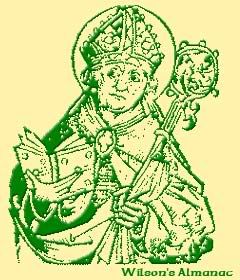Gloria olivae: St. Malachy's Prophecy
When I turned on my television set this morning at 7am to tune into CNN for news on the conclave, what greeted me was footage of the newly-elected Pope, Cardinal Joseph Ratzinger of Germany. I was dumbfounded because of his choice for a papal name - Benedict XVI.
A few days earlier, I was rummaging through a bunch of websites dealing with prophecies on the apocalypse, or the end of the world. A validated version - the Fatima prophecies - was already the subject of a prior article of mine which I wrote during the interregnum, or the period immediately after the late John Paul II's death wherein there was no Pope. Yet.
And then there was the prohecy of St. Malachy, a treatise that dealt with predictions on the line of succession to the throne of St. Peter - otherwise known as the Roman Catholic Papacy.

St. Malachy O'More
St. Malachy O'More is also known as "the Irish Nostradamus". What brings him to fame in the roster of saints of the Catholic Church is his 1139 AD work Prophecies of the Popes. He was visiting then Pope Innocent II to report on the affairs of his diocese (Armagh). Having St. Bernard - his contemporary - as a biographer, he is said to be one of the most documented saints in the Church.
The author Abbé Cucherat is said to have written of his vision while at Rome. Cucherat writes of Malachy's strange vision of the future that allowed him to list, in chronological order, the pontiffs who shall rule the Roman Catholic Church until armageddon. He did not write names, however. Instead, mystical and enigmatic mottoes were given to describe each Pope.
Note however that some Church scholars doubt whether the latter part of Malachy's list is authentic, because one prevailing view today is that some Jesuits in the 1600s tampered with the list, effectively making succeeding mottoes as forgeries. Supposed proofs for this view say that until that period, there was a clear relationship between each motto and the Pope given it. Afterwards, extensive references or allusions would have to be made just to "fit" the Pope into the motto.
On the other hand, it is said that St. Malachy gave his list to Pope Innocent II, who left it untouched in the Roman Archives until its revelation in the year 1590. Some say that the span of 400+ years from Malachy's vision to the discovery of the document proves that it is authentic, and no forgeries took place.
While it is left to us in the present day to discern if indeed the prophecy is authentic, here are some mottoes of recent popes, and the justifications on why they fit the motto:
John XXIII (1958-1963): Pastor et Nauta - pastor and marineAfter De labore Solis comes the motto for John Paul II's successor: Gloria olivae, or glory of the olives. Analysts said that either the next Pope would come from a Mediterranean country (areas rich in olive trees), or would have olive-colored skin (as in the case of latinos). Church scholars say that a symbolic meaning of the motto would be that of the Order of St. Benedict - who they say is represented by olives.
Prior to his election he was patriarch of Venice, a marine city, home of the gondolas.
Paul VI (1963-1978): Flos florum - flower of flowers
His coat of arms displayed three lilies.
John Paul I (1978): De medietate Lunae - of the half of the moon
He was born in the Diocese of Belluno (beautiful moon). His reign lasted for only a month - from half a moon to the next half.
John Paul II (1978-2005): De labore Solis - from the labor of the sun
Karol Wojtyla was born on 18 May 1920 during a solar eclipse. His funeral last 8 April 2005 coincided with another solar eclipse visible in the Americas.
And just yesterday, the 265th successor of St. Peter - Cardinal Joseph Ratzinger - chose for himself the name Benedict XVI.
That's not the scary part, if one may think of it that way. What's chilling is that St. Malachy's list enumerates Gloria olivae as the second to the last motto. The last, Petrus Romanus, has this entry in latin:
In persecutione extrema S.R.E. sedebit Petrus Romanus, qui pascet oves in multis tribulationibus: quibus transactis civitas septicollis diruetur, & Judex tremêdus judicabit populum suum. Finis.Which, upon understanding, would mean that the Pope after Gloria olivae would be the last Pope. Some even say that it's either Petrus Romanus or his successor who will be the Anti-Christ.
(In extreme persecution, the seat of the Holy Roman Church will be occupied by Peter the Roman, who will feed the sheep through many tribulations, at the term of which the city of seven hills will be destroyed, and the formidable Judge will judge his people. The End.)
Now before you go and spread the bad news (if you vouch for the prophecy's authenticity and relation to current events), remember that a school of thought thinks the prophecy has been a forgery since the 1600s. And apart from our new Pope's name being Benedict, there has been no solid link to Cardinal Joseph Ratzinger's being from the Order of St. Benedict or having anything to do with olives.
Be a judex tremêdus please, and judge formidably the contents of this article before you think of doomsday scenarios.
Reference websites:
Catholic-Pages.com
Catholic Online
Wilson's Almanac - for the illustration of St. Malachy



0 Comments:
Post a Comment
<< Home